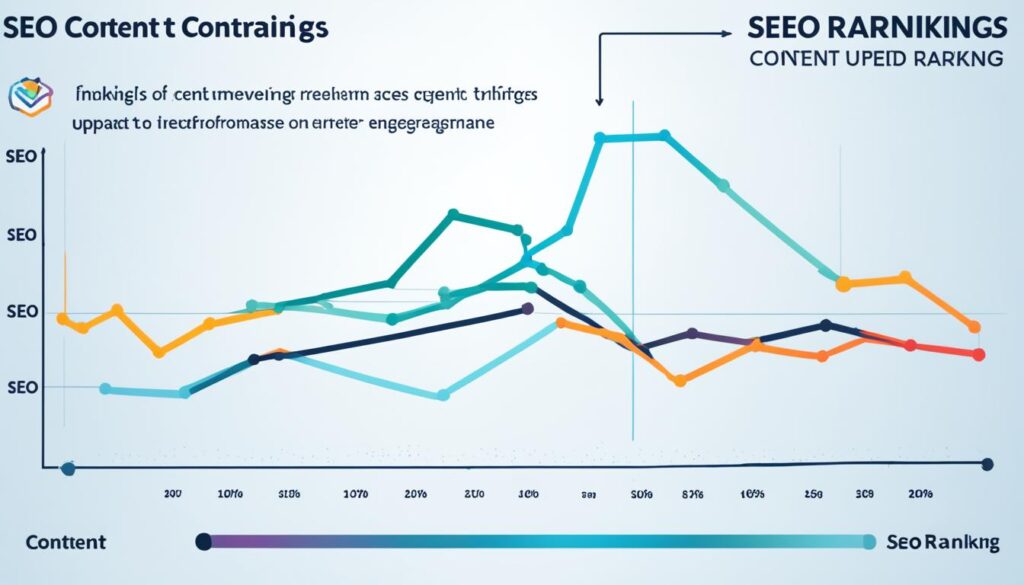
Websites are like living things in the huge world of the internet. Keeping them lively with updates is very important. These updates are a key way to show activity to both visitors and search engines. Unlike what some people think, search engines don’t like websites that never change. They see them as “dead,” with nothing new to give.
By updating often with high-quality content, a website shows its importance to search engines. This regular updating gets search engines to check the site more, which makes it more visible. This, in turn, helps the site move up in search rankings.
Adding new pages, blog posts, and articles is great for SEO and can bring more visitors. It’s important to focus on the quality of every piece. Websites that refresh their content daily or a few times a week are seen positively by search engines like Google. This not only helps with being seen more but also brings in more valuable visitors.
Refreshing your content regularly can also make your website more authoritative. Authority sites have lots of pages that Google finds valuable. Plus, if your content is always fresh and good, loyal users will keep coming back. Websites that update often can climb higher in rankings, becoming top sources in their fields.
Key Takeaways
- Regular content updates send vital activity signals to search engines.
- High-quality, frequent updates improve search engine indexing and overall visibility.
- Consistently fresh content builds website authority through backlinks.
- Frequent updates attract loyal users, increasing engagement and potential sales.
- Quality content is critical; it’s not just about quantity but the value offered.
The Importance of Fresh Content for SEO
Fresh content is key to boosting SEO by matching algorithmic factors used in rankings. The Freshness Algorithm by Google, from 2011, highlights the need for updated content. This helps your site become more visible and easier for Googlebots to find and rank.
Why Search Engines Favor Fresh Content
Google and other search engines value content freshness to improve user experience. They aim to provide the newest information for relevant queries. By updating regularly, sites can attract a wider audience with new keywords.
Advantages of Regular Updates
Posting new content regularly brings many advantages:
- Better search engine rankings due to more efficient indexing.
- Chance to connect with more specific, valuable keywords.
- Increased site credibility which leads to more backlinks.
- Better user engagement metrics, like longer visits and lower bounce rates.
- More content for social media shares, boosting referral traffic.
Impact on Website Authority
Updating content often makes a site a reliable industry source. It builds trust and encourages backlinks, crucial for SEO success. Sites with regular updates get more attention from Googlebots, improving indexing.
| Frequency of Updates | Impact on Rankings | User Engagement |
|---|---|---|
| Daily | High | Significant |
| Weekly | Moderate | Substantial |
| Monthly | Low | Minimal |
Understanding Content Freshness and its Benefits
Keeping your site’s content up to date is key for top search engine optimization results and keeping users interested. Adding new content regularly helps bring in visitors. It also keeps your online presence strong.
What Does Fresh Content Mean?
Fresh content means making new posts, not just tweaking old ones. Adding new blog posts, articles, and interactive stuff helps your site’s SEO. Google likes new content since its Freshness Update in 2011. It looks for the latest info for certain searches.
How Fresh Content Drives Traffic
New, interesting content helps your site show up more on search engines. For blogs and sites with lots of content, it’s crucial to keep them updated to stay ranked high. Adding new stuff and updating old posts helps with links. This boosts your site’s authority.
Use tools like BiQ’s Keyword Intelligence for better keyword use and planning your content. This will help your site stay top in search results. It will also keep bringing in users.
How Frequent Updates Enhance SEO Optimization Strategies
Frequent updates to your website are key to good SEO. They keep the site fresh and help it rank better. Search engines like Google send bots to check your site often when you do this.

The Role of Googlebots and Crawlers
Googlebots and crawlers scan the internet, putting websites in order. They look at keywords, links, and how often you update. Sites with new content get noticed more by these bots, boosting their presence online.
Indexing Frequency and Ranking Factors
Updating your content often helps with SEO by making your site more visible. Google prefers sites that offer new and useful info. This is especially important in fields where the latest information is crucial.
Google says “Your Money or Your Life” topics need regular updates for accuracy. Topics that are time-sensitive also need fresh content often. A regular update schedule keeps your SEO strong.
To see how updates aid SEO, here are some guidelines:
| Activity | Frequency |
|---|---|
| Technical SEO Audits | Every 1-3 months |
| Local SEO Audits | Quarterly |
| On-Page Optimizations | Every 1-2 months |
| Content Revision for Accuracy | Monthly, Quarterly, Annually |
| Publishing New Content | 1-2 times per month |
| Keyword Reevaluation | Every 3-6 months |
Setting a schedule for updates is important. It addresses SEO needs and keeps your content accurate. This way, you engage users, stay competitive, and get more visits from searches. Regular, high-quality updates are great for your SEO efforts.
Why and How to Keep Your Content Updated for Better SEO
In today’s changing SEO world, keeping your website on top is key. Knowing which content is out of date is important. Old or off-topic content can make users leave and hurt your rankings.
Identifying Outdated Content
First, find what content needs a refresh. This might be:
- Articles with old stats or facts
- Blog posts not matching current trends
- Pages with broken links or old SEO tactics
Taking action to update content boosts your site’s authority. Sites with fresh content rank better because they seem more relevant.
Effective Methods to Refresh Content
After spotting outdated content, it’s time to brighten it up. Try these:
- Update Metadata: Revise meta tags, alt text, and share your content online for better visibility.
- Incorporate Fresh Keywords: Add new keywords to match current trends and user searches.
- Leverage Multimedia: Update with new photos, videos, or interactive elements for a better user experience.
Refreshing your content boosts user interest and search rankings. Writing keyword-rich blogs, especially, can raise your SEO scores.
To wrap up, keeping content current is vital for a top website. By using these tips, your content stays new, relevant, and trustworthy for your audience.
Maximizing Keyword Optimization with Updated Content
To stay ahead in search rankings, updating your content is key. Refreshing old posts can engage your audience more. It also helps you use new keywords better.
Incorporating New Keywords
As trends change, new keywords become important. By looking at the latest search data, you can find terms your audience likes. Using these terms in your updates can greatly help your SEO.
- Review trending keywords related to your industry.
- Update meta tags and title descriptions with new keywords.
- Ensure keyword diversity to capture varied search intents.
Maintaining Content Quality and Relevance
Google prefers quality over lots of keywords. So, it’s crucial to keep your content both high-quality and relevant. Good content meets users’ needs, building trust and authority. This boosts your ranking on search engines.
Key strategies to maintain content quality:
- Ensure all information is up-to-date and accurate.
- Integrate keywords organically within the text.
- Add new insights or data to provide fresh perspectives.
| Aspects | Impact on SEO |
|---|---|
| Keyword Optimization | Boosts search engine visibility by targeting relevant search terms. |
| Content Relevance | Enhances the user experience, leading to higher engagement and trust. |
| Regular Updates | Signals to search engines that your site is active and authoritative. |
By updating your content and using keywords wisely, you can improve your SEO. This leads to more traffic and conversions for your website.
Capitalizing on Evergreen Content
Evergreen content is key for websites wanting to be seen as an industry authority. It keeps its value over time, pulling in readers again and again. Let’s explore how to make the most of this timeless strategy:
Evergreen content can be in many forms like how-to guides and listicles. These keep visitors coming regularly. It’s important to update them to stay on top of trends. This way, they keep ranking high in searches and stay relevant to what people are looking for.
Using the right keywords throughout your content boosts its SEO. Getting links from well-known sites also helps it become more trustworthy. But, keeping content up-to-date means fixing any broken links and refreshing statistics. Doing this keeps the content active and keeps its search ranking strong.
Refreshing content usually includes these steps:
- Choose evergreen content that has a lot of potential for updates.
- Review these pages to see what could be better.
- Update the content with new info and keywords.
- After updating, check how well the changes are doing.
Merging several posts into one detailed article can really boost its impact and draw more visitors. Making new content, reporting on current events, and updating what’s already there are all part of a good content plan.
| Type of Content | Average Duration of Time to Rank Initially | Duration of Time the Content Can Drive Traffic For |
|---|---|---|
| Evergreen Content | 3-6 months | Years |
| News Content | Days to Weeks | Weeks to Months |
It’s crucial to keep up with new trends and what the audience likes. This keeps your site interesting and relevant, making sure it remains a trusted industry authority.
Using User Engagement Metrics to Guide Updates
It’s important to understand user engagement metrics to drive your content strategy. These metrics help see how users interact with your site. They guide updates to make content more interesting and relevant to your audience.
Analyzing User Behavior
Studying how visitors act on your site is vital. Metrics like Pages Per Session, Average Session Duration, and Time on Page are key. They show if users like your content and how deep their interest goes. For example, longer sessions mean users value your content.
- Pages Per Session: Shows the number of pages viewed in one visit, indicating content relevance.
- Average Session Duration: Tells us how long users stay, with longer times showing more interest.
- Time on Page: How long visitors stay on a page, hinting at content quality.
- Interactions Per Visit: Covers all types of interactions like comments, shares, and video views.
- Conversion Rate: Shows how well your engagement strategies work by the action completion rate.
Understanding Feedback and Comments
User feedback and comments are crucial for tweaking your content approach. They provide direct input on user experiences and wishes. Surveys and polls help gather continual insights. Analytics track how engaging your content is, while comments show user thoughts. Platforms like The Oatmeal and BuzzFeed use quizzes to collect emails, which enhances interaction.
| Metric | Description | Insight |
|---|---|---|
| Pages Per Session | Number of pages viewed per visit | Reflects content relevance |
| Average Session Duration | Time spent on the site | Indicates user engagement |
| Time on Page | Duration on individual pages | Measures content quality |
| Interactions Per Visit | Comments, shares, video plays | Signifies user engagement levels |
| Conversion Rate | Percentage fulfilling desired actions | Shows engagement strategy effectiveness |
Effectively using user engagement metrics is crucial for a successful content strategy. By keeping an eye on these metrics and adapting your content, you can better meet your audience’s needs. This leads to more engagement and growth over time.
Keeping Your Audience Informed and Engaged
Regular updates to your site’s content are key to keeping your audience in the loop. These updates provide value and build community, which boosts customer satisfaction and loyalty. This makes sure your audience keeps coming back, improving your site’s authority and Google ranking.
Staying updated lets you match your content with what users want, which is key to keeping them happy. This leads to more engaging content. It makes users spend more time on your site and may boost your search engine ranking.
Including various SEO strategies helps keep your content both relevant and engaging. Here are a few useful tips:
- Do thorough keyword research to understand what your audience is looking for.
- Make sure relevant keywords are in your text, titles, and meta descriptions.
- Use both internal and external links to improve site navigation and authority.
- Add visuals and strong calls-to-action (CTAs) to make your content richer.
- Check your content regularly for outdated info and update as needed.
These tactics are part of a bigger plan aimed at adding value, improving user experience, and increasing customer satisfaction. Below is a table showing how certain SEO elements help keep your audience informed and improve customer satisfaction:
| SEO Element | Contribution to Informed Audience | Impact on Customer Satisfaction |
|---|---|---|
| Keyword Optimization | Makes content match user searches | Boosts content relevance and engagement |
| Regular Content Updates | Ensures info is up-to-date and useful | Builds trust and reliability |
| Internal Linking | Makes site easier to navigate | Offers a smooth user experience |
| Visuals and CTAs | Improves content quality and interaction | Leads to more conversions and engagement |
Focusing on these areas ensures your content meets and exceeds audience expectations, leading to greater satisfaction and loyalty. This approach is crucial in today’s fast-paced digital world.
Technical Aspects of Updating Content
Keeping your website content up-to-date is crucial for top SEO results. Doing content audits and using SEO tools are essential.

Regular Audits and Maintenance
Doing regular content audits is key. It helps fix old content and issues that affect performance. Google’s search algorithms pay attention to how fresh and relevant your content is.
These audits let you dive into user engagement. You’ll see where your content might be falling short by looking at bounce rates and page views. Tools like Google Analytics help spot blog posts that aren’t doing well.
- With billions of web pages out there, updating regularly helps you stand out.
- 74% of bloggers say updating old content is critical for their strategy.
- Many companies focus on making new content rather than fixing old, leading to content decay.
Using SEO Tools for Content Updates
Adding SEO tools to your strategy improves content visibility. Use Ahrefs, Google Search Console, and SEMrush for insights. They help find new keywords and learn what competitors are doing. This ensures your updates are on point.
- Ahrefs: Finds keywords close to ranking high and checks backlinks.
- Google Search Console: Keeps an eye on how your site’s doing and any indexing issues.
- SEMrush: Shows what competitors are doing and helps with keyword research.
By using these SEO tools, you make sure everything technical is tuned up. This includes Meta tags and schema markup, which help your content stand out in search results. Regularly refreshing your content and using the right tools boosts relevance, user experience, and rankings.
Conclusion
Keeping your online content fresh with regular updates is key for any business’s success on the internet. It’s often easier and uses fewer resources to update old blog posts than to write new ones. These updates can lead to more clicks, better visibility, and a lot more visitors from Google.
When you refresh content, you’re not just increasing clicks. You’re also likely to see higher sales and conversions. A good blog post can stay on top of Google searches for many years. This gives it lasting value. Using tools like Grammarly and Broken Link Checker ensures your content stays top-notch.
Title tags and Meta Descriptions are very important for improving click-through rates (CTR). They make a big difference in how often people choose to click on your content.
Using links well, both inside and outside your website, boosts your SEO ranking. Up-to-date content is more appealing to search engines, which means higher placements and more people seeing your site. Adding things like videos and making sure your updates match your overall goals can bring back visitors. This helps you get the most out of your investment. Keeping your strategy sharp means your site stays important, useful, and up-to-date.

